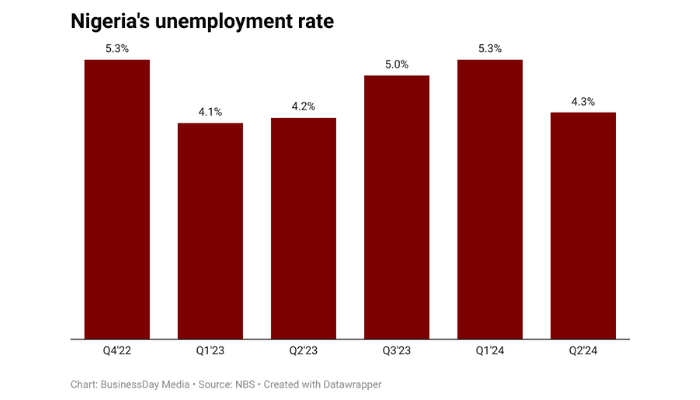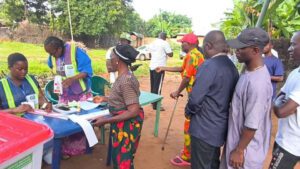Nigeria’s unemployment rate fell to 4.3% in the second quarter of 2024, down from 5.3% in Q1 2024, signaling an improvement in labor market conditions. This marks a gradual recovery, with rates stabilizing from 5.0% in Q3 2023, according to a report released by the National Bureau of Statistics (NBS) on Monday.
Key Indicators of Improved Employment
- Labour Force Participation Rate: Increased to 79.5% in Q2, up from 77.3% in Q1, highlighting greater workforce engagement.
- Employment-to-Population Ratio: Climbed to 76.1% from 73.2%, showing a higher proportion of the working-age population employed.
- Self-Employment Dominance: Self-employment accounted for 85.6% of total employment, up from 84% in Q1.
- Informal Employment: Slightly rose to 93.0%, underlining the economy’s reliance on informal job opportunities.
Urban vs. Rural Employment Trends
- Urban Unemployment: Decreased to 5.2% from 6.0% in Q1, reflecting growth in formal jobs and service-driven employment.
- Rural Unemployment: Dropped to 2.8% from 4.3%, highlighting agriculture and informal activities as significant employment sources in rural areas.
Youth and Gender Employment Metrics
- Youth Unemployment (Ages 15–24): Declined significantly to 6.5%, compared to 8.4% in Q1.
- Gender Disparity: Female unemployment stood at 5.1%, higher than the 3.4% for males, underscoring the need for gender-inclusive employment policies.
Underemployment and Labour Underutilisation
- Time-Related Underemployment: Dropped to 9.2% in Q2 from 10.6% in Q1, reflecting reduced demand for additional working hours.
- Labour Underutilisation Metrics:
- LU2 (Unemployment + Underemployment): Fell to 13.0% from 15.3%.
- LU3 and LU4: Declined to 5.9% and 14.5%, respectively, indicating better use of labor resources.
The report highlights significant strides in Nigeria’s labor market recovery, with rural employment and self-employment driving these improvements. However, gender disparities and reliance on informal jobs remain areas for policy intervention.
Stay tuned to 9am News Nigeria for more Breaking News, Business News, Sports updates And Entertainment Gists.
Post Views: 249
















